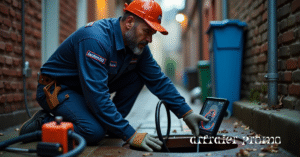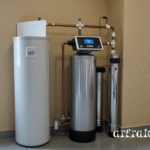A damaged or failing sewer line is every homeowner’s nightmare. From foul smells to backed-up drains, the consequences can be messy and expensive. Knowing when to replace your sewer line, the causes of damage, signs to watch for, and whether it’s a DIY job or a task for professionals can save you time, money, and stress.
Let’s explore everything you need to know about sewer line replacement—from causes and costs to repair methods and decision-making.
Common Causes of Sewer Line Damage
Understanding what causes sewer line problems can help prevent future issues. Here are the most common culprits:
-
Tree Root Infiltration: Roots from nearby trees can penetrate the pipe, causing blockages and cracks.
-
Aging or Corroded Pipes: Older homes may have clay, cast iron, or Orangeburg pipes that deteriorate over time.
-
Shifting Soil or Ground Movement: Earthquakes, construction, or natural settling can shift and crack pipes.
-
Grease, Debris, and Foreign Objects: Years of improper flushing or dumping grease down the drain can cause severe clogs.
-
Poor Installation or Design: A pipe that wasn’t properly sloped or supported may fail prematurely.
Signs You May Need to Replace Your Sewer Line
Not sure if you have a serious problem? Watch for these red flags:
-
Frequent Drain Backups: Especially in lower-level fixtures.
-
Gurgling Sounds: Coming from toilets or drains when other fixtures are in use.
-
Foul Sewage Odors: Around the home or yard.
-
Soggy Patches in the Lawn: Even when it hasn’t rained.
-
Multiple Drain Clogs at Once: Indicates a blockage deeper in the line.
-
Pest Infestations: Rodents or insects attracted to leaks or cracks in your sewer line.
Sewer Line Repair vs. Replacement
Not all sewer line problems require a full replacement. Here’s how to decide:
| Problem Type | Repair or Replace? | Notes |
|---|---|---|
| Small cracks or minor leaks | Repair | Pipe lining or spot repairs work well |
| Severe tree root invasion | Replace | Roots can destroy entire sections |
| Collapsed or crushed pipes | Replace | Must be dug up or burst and replaced |
| Old clay or Orangeburg pipes | Replace | Often too fragile for repair |
| Localized clog or blockage | Repair | Hydro jetting or snaking may suffice |
Sewer Line Replacement Methods
There are several ways to replace a sewer line. Each has pros, cons, and cost implications:

1. Traditional Trench Method
-
Process: Dig a trench to access and replace the pipe.
-
Best for: Severe damage, full replacements.
-
Pros: Simple and widely available.
-
Cons: Destructive to landscaping, sidewalks, driveways.
2. Trenchless Sewer Line Replacement
-
Types: Pipe bursting and pipe lining (CIPP).
-
Best for: Minimally invasive repair or full replacement.
-
Pros: Faster, less mess, preserves yard.
-
Cons: Requires specific conditions and professional equipment.
For more details on how trenchless methods like pipe bursting, slip‑lining, and CIPP work, check out this helpful article on trenchless pipe repair.
3. Pipe Bursting
-
A new pipe is pulled through the old one, breaking it apart.
-
Works for major damage or full replacement.
4. Cured-in-Place Pipe (CIPP) Lining
-
A resin-coated liner is inserted and cured inside the old pipe.
-
Good for moderate damage and pipe strengthening.
Cost to Replace a Sewer Line
Sewer line replacement costs vary widely based on the method, location, pipe length, and material.
| Replacement Type | Average Cost (Per Foot) | Total Cost Range |
|---|---|---|
| Traditional Dig & Replace | $50–$250 | $3,000 – $25,000+ |
| Trenchless Pipe Bursting | $60–$200 | $4,000 – $15,000 |
| CIPP Lining | $80–$250 | $4,000 – $20,000 |
Tip: Getting multiple quotes from licensed plumbers is essential for accurate pricing.
When to DIY and When to Call a Pro
DIY Sewer Line Work (Only if You’re Experienced)
-
Snaking a small clog
-
Cleaning out a clean-out access point
-
Routine sewer camera inspection (if you have the tool)
Warning: Replacing or repairing sewer pipes yourself without permits or professional tools can lead to code violations, damage, or worse, personal injury.

Call a Professional If:
-
The issue involves major pipe replacement or trenchless work.
-
There’s consistent clogging, foul smells, or sewage backup.
-
You need permits or a warranty-backed repair.
-
You live in an older home with clay or Orangeburg pipes.
Professional plumbers bring experience, tools, and certification that ensures the job is done safely and legally.
Conclusion
Replacing a sewer line isn’t a one-size-fits-all job. While minor clogs or maintenance can be done DIY, most repair or replacement jobs require a licensed professional—especially when using trenchless methods or dealing with severe pipe damage.
By understanding the causes, recognizing the warning signs, and comparing the costs and repair options, you’ll be better equipped to take action before a small issue becomes a costly disaster.
Frequently Asked Questions (FAQs)
Is sewer line replacement covered by homeowners insurance?
Usually not unless the damage is sudden and accidental (e.g., from a tree falling). Routine wear is typically not covered.
How long does sewer line replacement take?
Traditional methods may take 2–5 days, while trenchless methods can be completed in 1–2 days.
Can I replace my sewer line without digging?
Yes, trenchless methods like pipe bursting and pipe lining are designed to minimize digging.
How long does a new sewer line last?
New PVC or HDPE pipes can last 50–100 years if installed properly.






